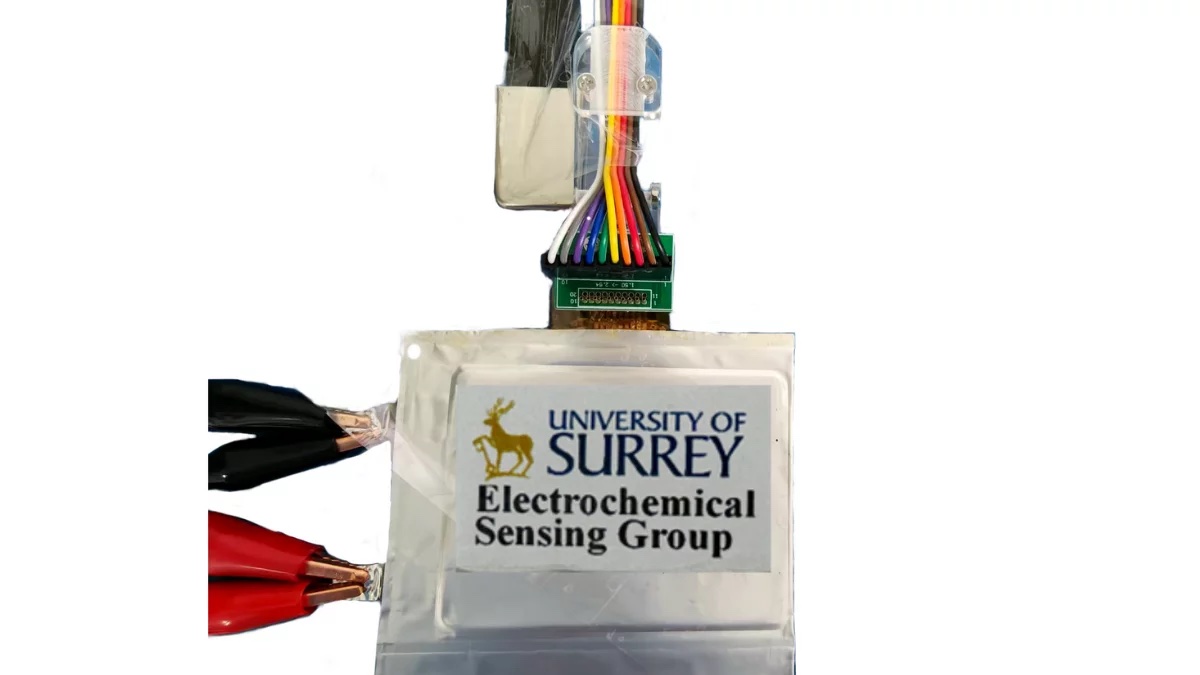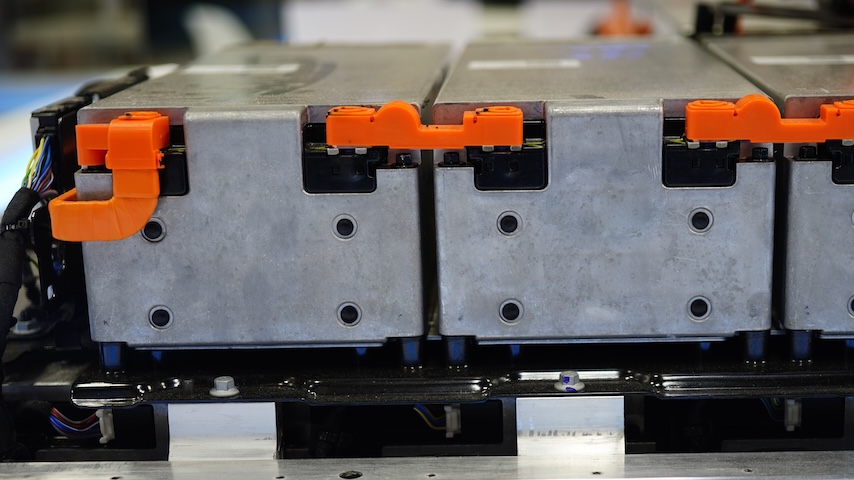New Embedded Sensor Tech Aims to Stop Lithium-Ion Fires Before They Start
New Embedded Sensor Tech Aims to Stop Lithium-Ion Fires Before They Start


Researchers at England’s University of Surrey are embedding smart sensors into lithium-ion batteries to detect and halt fires before they start.
Reports of fires, explosions and other disturbances caused by lithium-ion batteries are rampant in the news: a 76-year-old woman was killed in July when an e-bike battery exploded inside a Queens pizzeria, smoke filled an airplane cabin after a phone charger caught fire during a KLM Royal Dutch Airlines flight in August, and a fire at a lithium battery warehouse holding over 35,000 batteries killed 23 in South Korea in 2024.
Lithium-ion battery fires are difficult to extinguish because when a single cell in the battery overheats, it can set off a chain reaction in nearby cells that release heat, flammable gases, and oxygen, even though the battery could keep feeding the fire if and when external fuel sources are removed.
Those sorts of safety concerns spurred Kai Yang, a lecturer in Energy Materials and Nanotechnology at the University of Surrey in Guildford, Surrey, England, to get involved in a project to improve the safety of lithium-ion batteries by embedding sensors within the batteries rather than outside of them.
“After years in battery research, I realized the existing sensors only detect problems when it is too late,” Yang said. “With batteries powering everything from EVs to renewable energy, we can’t afford the safety failures that greatly risk our lives and future sustainable society. That’s why we are building battery sensors that don’t just monitor batteries but actively prevent disasters from inside.”
He compared current sensors to a thermometer taped to the outside of a battery.
“They are useful but blind to the real risks brewing inside,” he said. “For example, some commercial temperature sensors can track battery surface temperature, but they cannot detect dangerous internal temperature gradients, which can spike over 200 degrees in failing cells.”
While sensors located on the battery also react too slowly, the miniaturized sensors being developed at Surrey can detect the temperature distribution on critical battery regions such as the terminals, center, and edge, which assist with identifying hotspots.
“Our miniaturized and characterized sensor design will minimize the sensing cost while providing high sensing accuracy,” Yang said.
The technology pushes past passive thermal monitoring to include fire-retardant components integrated in the sensors to help prevent the battery from overheating.
“Our sensor technology integrates specific flame-retardant materials directly into sensor structures,” he said. “These chemicals remain inactive as robust sensor support during normal operation, but spring into action when the temperature reaches dangerous levels.”
The sensors work in multiple ways to stop fire—by absorbing heat, disrupting chemical reactions that spread flames or forming protective barriers.
Developing the smart sensors that are built into battery components such as collectors and separators required Yang to delve into various research areas.
“I have investigated energy materials and studied electrochemistry to understand how batteries function and degrade over time,” he said. “Another key part of my work involves insitu characterization techniques, which let me observe battery behavior in real time and under practical operating conditions.”
“I also explored battery management strategies to optimize battery system performance and safety using sensor data,” Yang added. “On the fabrication side, I used nanotechnology and microfabrication to develop the integrated and high-precision sensors.”
Along with Yang, more than ten researchers are working on the battery sensor project: two academics, four doctoral students, three technicians, and one technology transfer officer.
Working at the University of Surrey’s Advanced Technology Institute (ATI) has enhanced the sensor research.
“We have access to high-tech labs and equipment such as microfabrication clean room, scaled printing laboratory, electrochemistry laboratory, and a suite of advanced characterization tools, supporting sensor fabrication, battery assembly and testing, and advanced electrochemical characterization,” Yang said.
The team has developed multiple prototypes and witnessed many small victories that reinforced the belief that they are on the right track with embedding the sensors.
“Achieving successful prototypes was an incredible moment,” Yang says. “It was a real thrill when we realized that it was not just a lab result, but it could work in real batteries and under practical operation.”
A deadline of 2035 is looming in the United Kingdom when the sale of all new gas and diesel cars will be banned, however, the risk of battery fires remains a concern.
“These battery sensors are essential to improve safety and sustainability,” said Ravi Silva, director of the ATI and head of the NanoElectronics Centre. “This is the innovation we need to achieve net-zero targets, all the while supporting industry and delivering real benefits to end users.”
The university has filed a patent for the sensor and is looking to collaborate with academic and industry partners on the project.
Looking forward, Yang said the team wants to address various challenges including scaling production while minimizing cost, ensuring reliable performance across various battery types and chemistries, and validating long-term durability under extreme conditions.
Annemarie Mannion is a technology writer in Chicago.
Lithium-ion battery fires are difficult to extinguish because when a single cell in the battery overheats, it can set off a chain reaction in nearby cells that release heat, flammable gases, and oxygen, even though the battery could keep feeding the fire if and when external fuel sources are removed.
Those sorts of safety concerns spurred Kai Yang, a lecturer in Energy Materials and Nanotechnology at the University of Surrey in Guildford, Surrey, England, to get involved in a project to improve the safety of lithium-ion batteries by embedding sensors within the batteries rather than outside of them.
“After years in battery research, I realized the existing sensors only detect problems when it is too late,” Yang said. “With batteries powering everything from EVs to renewable energy, we can’t afford the safety failures that greatly risk our lives and future sustainable society. That’s why we are building battery sensors that don’t just monitor batteries but actively prevent disasters from inside.”
He compared current sensors to a thermometer taped to the outside of a battery.
“They are useful but blind to the real risks brewing inside,” he said. “For example, some commercial temperature sensors can track battery surface temperature, but they cannot detect dangerous internal temperature gradients, which can spike over 200 degrees in failing cells.”
Inside the battery, not outside
While sensors located on the battery also react too slowly, the miniaturized sensors being developed at Surrey can detect the temperature distribution on critical battery regions such as the terminals, center, and edge, which assist with identifying hotspots.
“Our miniaturized and characterized sensor design will minimize the sensing cost while providing high sensing accuracy,” Yang said.
The technology pushes past passive thermal monitoring to include fire-retardant components integrated in the sensors to help prevent the battery from overheating.
“Our sensor technology integrates specific flame-retardant materials directly into sensor structures,” he said. “These chemicals remain inactive as robust sensor support during normal operation, but spring into action when the temperature reaches dangerous levels.”
The sensors work in multiple ways to stop fire—by absorbing heat, disrupting chemical reactions that spread flames or forming protective barriers.
Developing the smart sensors that are built into battery components such as collectors and separators required Yang to delve into various research areas.
“I have investigated energy materials and studied electrochemistry to understand how batteries function and degrade over time,” he said. “Another key part of my work involves insitu characterization techniques, which let me observe battery behavior in real time and under practical operating conditions.”
“I also explored battery management strategies to optimize battery system performance and safety using sensor data,” Yang added. “On the fabrication side, I used nanotechnology and microfabrication to develop the integrated and high-precision sensors.”
Along with Yang, more than ten researchers are working on the battery sensor project: two academics, four doctoral students, three technicians, and one technology transfer officer.
Working at the University of Surrey’s Advanced Technology Institute (ATI) has enhanced the sensor research.
“We have access to high-tech labs and equipment such as microfabrication clean room, scaled printing laboratory, electrochemistry laboratory, and a suite of advanced characterization tools, supporting sensor fabrication, battery assembly and testing, and advanced electrochemical characterization,” Yang said.
The team has developed multiple prototypes and witnessed many small victories that reinforced the belief that they are on the right track with embedding the sensors.
“Achieving successful prototypes was an incredible moment,” Yang says. “It was a real thrill when we realized that it was not just a lab result, but it could work in real batteries and under practical operation.”
Toward a safer net-zero future
A deadline of 2035 is looming in the United Kingdom when the sale of all new gas and diesel cars will be banned, however, the risk of battery fires remains a concern.
“These battery sensors are essential to improve safety and sustainability,” said Ravi Silva, director of the ATI and head of the NanoElectronics Centre. “This is the innovation we need to achieve net-zero targets, all the while supporting industry and delivering real benefits to end users.”
The university has filed a patent for the sensor and is looking to collaborate with academic and industry partners on the project.
Looking forward, Yang said the team wants to address various challenges including scaling production while minimizing cost, ensuring reliable performance across various battery types and chemistries, and validating long-term durability under extreme conditions.
Annemarie Mannion is a technology writer in Chicago.


_1.jpg?width=500&height=281&ext=.jpg)


